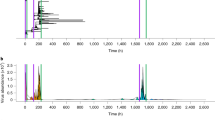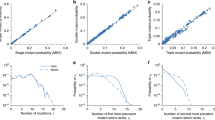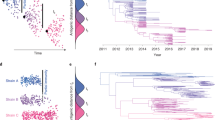Abstract
Antiviral immunity has been studied extensively from the perspective of virus−cell interactions, yet the role of virus−virus interactions remains poorly addressed. Here, we demonstrate that viral escape from interferon (IFN)-based innate immunity is a social process in which IFN-stimulating viruses determine the fitness of neighbouring viruses. We propose a general and simple social evolution framework to analyse how natural selection acts on IFN shutdown and validate it in cell cultures and mice infected with vesicular stomatitis virus. Furthermore, we find that IFN shutdown is costly because it reduces short-term viral progeny production, thus fulfilling the definition of an altruistic trait. Hence, in well-mixed populations, the IFN-blocking wild-type virus is susceptible to invasion by IFN-stimulating variants and spatial structure consequently determines whether IFN shutdown can evolve. Our findings reveal that fundamental social evolution rules govern viral innate immunity evasion and virulence and suggest possible antiviral interventions.
This is a preview of subscription content, access via your institution
Access options
Access Nature and 54 other Nature Portfolio journals
Get Nature+, our best-value online-access subscription
$29.99 / 30 days
cancel any time
Subscribe to this journal
Receive 12 digital issues and online access to articles
$119.00 per year
only $9.92 per issue
Buy this article
- Purchase on Springer Link
- Instant access to full article PDF
Prices may be subject to local taxes which are calculated during checkout






Similar content being viewed by others
Data availability
No restrictions apply to data availability. Relevant data are provided in the manuscript and the Supplementary Information. All data are available from the corresponding author upon request. No new protein, DNA or RNA sequence data, macromolecular structures, crystallographic data or microarray data requiring deposition in public repositories were produced.
References
Nowak, M. A. Five rules for the evolution of cooperation. Science 314, 1560–1563 (2006).
Fletcher, J. A. & Doebeli, M. A simple and general explanation for the evolution of altruism. Proc. Biol. Sci. 276, 13–19 (2009).
Gardner, A., West, S. A. & Wild, G. The genetical theory of kin selection. J. Evol. Biol. 24, 1020–1043 (2011).
Díaz-Munoz, S. L., Sanjuán, R. & West, S. Sociovirology: conflict, cooperation, and communication among viruses. Cell Host Microbe 22, 437–441 (2017).
Turner, P. E. & Chao, L. Prisoner’s dilemma in an RNA virus. Nature 398, 441–443 (1999).
Skums, P., Bunimovich, L. & Khudyakov, Y. Antigenic cooperation among intrahost HCV variants organized into a complex network of cross-immunoreactivity. Proc. Natl Acad. Sci. USA 112, 6653–6658 (2015).
Erez, Z. et al. Communication between viruses guides lysis-lysogeny decisions. Nature 541, 488–493 (2017).
Borges, A. L. et al. Bacteriophage cooperation suppresses CRISPR-Cas3 and Cas9 immunity. Cell 174, 917–925 (2018).
Xue, K. S., Hooper, K. A., Ollodart, A. R., Dingens, A. S. & Bloom, J. D. Cooperation between distinct viral variants promotes growth of H3N2 influenza in cell culture.eLife 5, e13974 (2016).
Leggett, H. C., Brown, S. P. & Reece, S. E. War and peace: social interactions in infections. Phil. Trans. R. Soc. B 369, 20130365 (2014).
Xavier, J. B. Sociomicrobiology and pathogenic bacteria. Microbiol. Spectr. https://doi.org/10.1128/microbiolspec.VMBF-0019-2015 (2016).
Ivashkiv, L. B. & Donlin, L. T. Regulation of type I interferon responses. Nat. Rev. Immunol. 14, 36–49 (2014).
Fensterl, V., Chattopadhyay, S. & Sen, G. C. No love lost between viruses and interferons. Annu. Rev. Virol. 2, 549–572 (2015).
García-Sastre, A. Ten strategies of interferon evasion by viruses. Cell Host Microbe 22, 176–184 (2017).
Coccia, E. M. & Battistini, A. Early IFN type I response: learning from microbial evasion strategies. Semin. Immunol. 27, 85–101 (2015).
Lion, S., Jansen, V. A. & Day, T. Evolution in structured populations: beyond the kin versus group debate. Trends Ecol. Evol. 26, 193–201 (2011).
Birch, J. Kin selection, group selection, and the varieties of population structure. Brit. J. Phil. Sci. https://doi.org/10.1093/bjps/axx028 (2018).
Lehtonen, J. Multilevel selection in kin selection language. Trends Ecol. Evol. 31, 752–762 (2016).
Marshall, J. A. Group selection and kin selection: formally equivalent approaches. Trends Ecol. Evol. 26, 325–332 (2011).
West, S. A., Griffin, A. S., Gardner, A. & Diggle, S. P. Social evolution theory for microorganisms. Nat. Rev. Microbiol. 4, 597–607 (2006).
O’Brien, S., Luján, A. M., Paterson, S., Cant, M. A. & Buckling, A. Adaptation to public goods cheats in Pseudomonas aeruginosa. Proc. Biol. Sci. 284, 20171089 (2017).
Jin, Z. et al. Conditional privatization of a public siderophore enables Pseudomonas aeruginosa to resist cheater invasion. Nat. Commun. 9, 1383 (2018).
Rajani, K. R. et al. Complexes of vesicular stomatitis virus matrix protein with host Rae1 and Nup98 involved in inhibition of host transcription. PLoS Pathog. 8, e1002929 (2012).
Quan, B., Seo, H. S., Blobel, G. & Ren, Y. Vesiculoviral matrix (M) protein occupies nucleic acid binding site at nucleoporin pair (Rae1 * Nup98). Proc. Natl Acad. Sci. USA 111, 9127–9132 (2014).
Stojdl, D. F. et al. VSV strains with defects in their ability to shutdown innate immunity are potent systemic anti-cancer agents. Cancer Cell 4, 263–275 (2003).
Voigt, E. A., Swick, A. & Yin, J. Rapid induction and persistence of paracrine-induced cellular antiviral states arrest viral infection spread in A549 cells. Virology 496, 59–66 (2016).
Howat, T. J., Barreca, C., O’Hare, P., Gog, J. R. & Grenfell, B. T. Modelling dynamics of the type I interferon response to in vitro viral infection. J. R. Soc. Interface 3, 699–709 (2006).
Samuel, C. E. & Knutson, G. S. Mechanism of interferon action. Kinetics of decay of the antiviral state and protein phosphorylation in mouse fibroblasts treated with natural and cloned interferons. J. Biol. Chem. 257, 6 (1982).
Zwart, M. P. & Elena, S. F. Matters of size: genetic bottlenecks in virus infection and their potential impact on evolution. Annu. Rev. Virol. 2, 161–179 (2015).
Gutiérrez, S., Michalakis, Y. & Blanc, S. Virus population bottlenecks during within-host progression and host-to-host transmission. Curr. Opin. Virol. 2, 546–555 (2012).
McCrone, J. T. & Lauring, A. S. Genetic bottlenecks in intraspecies virus transmission. Curr. Opin. Virol. 28, 20–25 (2018).
Richard, M., Herfst, S., Tao, H., Jacobs, N. T. & Lowen, A. C. Influenza A virus reassortment is limited by anatomical compartmentalization following co-infection via distinct routes. J. Virol. https://doi.org/10.1128/JVI.02063-17 (2017).
Salemi, M. & Rife, B. Phylogenetics and phyloanatomy of HIV/SIV intra-host compartments and reservoirs: the key role of the central nervous system. Curr. HIV Res. 14, 110–120 (2016).
Detje, C. N. et al. Local type I IFN receptor signaling protects against virus spread within the central nervous system. J. Immunol. 182, 2297–2304 (2009).
Francoeur, A. M., Poliquin, L. & Stanners, C. P. The isolation of interferon-inducing mutants of vesicular stomatitis virus with altered viral P function for the inhibition of total protein synthesis. Virology 160, 236–245 (1987).
Novella, I. S., Hershey, C. L., Escarmís, C., Domingo, E. & Holland, J. J. Lack of evolutionary stasis during alternating replication of an arbovirus in insect and mammalian cells. J. Mol. Biol. 287, 459–465 (1999).
Cuevas, J. M., Elena, S. F. & Moya, A. Molecular basis of adaptive convergence in experimental populations of RNA viruses. Genetics 162, 533–542 (2002).
Remold, S. K., Rambaut, A. & Turner, P. E. Evolutionary genomics of host adaptation in vesicular stomatitis virus. Mol. Biol. Evol. 25, 1138–1147 (2008).
Morita, K., Vanderoef, R. & Lenard, J. Phenotypic revertants of temperature-sensitive M protein mutants of vesicular stomatitis virus: sequence analysis and functional characterization. J. Virol. 61, 256–263 (1987).
Brun, J. et al. Identification of genetically modified Maraba virus as an oncolytic rhabdovirus. Mol. Ther. 18, 1440–1449 (2010).
Furió, V. et al. Relationship between within-host fitness and virulence in the vesicular stomatitis virus: correlation with partial decoupling. J. Virol. 86, 12228–12236 (2012).
Sanjuán, R., Moya, A. & Elena, S. F. The distribution of fitness effects caused by single-nucleotide substitutions in an RNAvirus. Proc. Natl Acad. Sci. USA 101, 8396–8401 (2004).
Marcus, P. I., Rodríguez, L. L. & Sekellick, M. J. Interferon induction as a quasispecies marker of vesicular stomatitis virus populations. J. Virol. 72, 542–549 (1998).
Pfeiffer, T., Schuster, S. & Bonhoeffer, S. Cooperation and competition in the evolution of ATP-producing pathways. Science 292, 504–507 (2001).
Stanley, D., Bandara, A., Fraser, S., Chambers, P. J. & Stanley, G. A. The ethanol stress response and ethanol tolerance of Saccharomyces cerevisiae. J. Appl. Microbiol. 109, 13–24 (2010).
Hastie, E. & Grdzelishvili, V. Z. Vesicular stomatitis virus as a flexible platform for oncolytic virotherapy against cancer. J. Gen. Virol. 93, 2529–2545 (2012).
Clarke, D. K. et al. Live virus vaccines based on a vesicular stomatitis virus (VSV) backbone: standardized template with key considerations for a risk/benefit assessment. Vaccine 34, 6597–6609 (2016).
Brown, S. P., West, S. A., Diggle, S. P. & Griffin, A. S. Social evolution in micro-organisms and a Trojan horse approach to medical intervention strategies. Phil. Trans. R. Soc. B 364, 3157–3168 (2009).
Lawson, N. D., Stillman, E. A., Whitt, M. A. & Rose, J. K. Recombinant vesicular stomatitis viruses from DNA. Proc. Natl Acad. Sci. USA 92, 4477–4481 (1995).
Palmero, I. & Serrano, M. Induction of senescence by oncogenic Ras. Methods Enzymol. 333, 247–256 (2001).
Acknowledgements
We thank I. Noguera for technical assistance with the animal experiments, J. M. Cuevas, R. Garijo and I. Andreu-Moreno for help with the experimental set up, V. Grdzelishvili for the VSV clones, C. Rivas for the MEFs, and S. West and P. Carazo for helpful discussions. This work was funded by ERC Consolidator Grant 724519 Vis-a-Vis to R.S. P.D.-C. was also funded by a Juan de la Cierva Incorporación postdoctoral contract from the Spanish MINECO.
Author information
Authors and Affiliations
Contributions
P.D.-C. performed the cell culture experiments. E.S.-O. contributed to designing the model. M.D.-M. performed the animal experiments. R.S. conceived the study, formulated the model, analysed the data and wrote the manuscript.
Corresponding author
Ethics declarations
Competing interests
The authors declare no competing interests.
Additional information
Publisher’s note: Springer Nature remains neutral with regard to jurisdictional claims in published maps and institutional affiliations.
Supplementary information
Supplementary Information
Supplementary Figures 1–6 and Supplementary Table 1.
Supplementary Video 1
Progression of a VSV WT–mCherry infection (red) in a MEF culture (phase contrast). The infection spreads until the entire culture is invaded.
Supplementary Video 2
Progression of a VSV Δ51–GFP infection (green) in a MEF culture (phase contrast). The infection spreads from initially infected cells to neighbour cells efficiently, but is subsequently halted by innate immunity.
Supplementary Video 3
Progression of a mixed infection containing both VSV WT–mCherry (red) and VSV Δ51–GFP (green) variants in a MEF culture (phase contrast). The infection spreads from initially infected cells to neighbour cells efficiently, but is subsequently halted by innate immunity. This shows that the presence of the Δ51 variants exerts an inhibitory effect on the WT virus.
Rights and permissions
About this article
Cite this article
Domingo-Calap, P., Segredo-Otero, E., Durán-Moreno, M. et al. Social evolution of innate immunity evasion in a virus. Nat Microbiol 4, 1006–1013 (2019). https://doi.org/10.1038/s41564-019-0379-8
Received:
Accepted:
Published:
Issue Date:
DOI: https://doi.org/10.1038/s41564-019-0379-8
This article is cited by
-
Quasispecies productivity
The Science of Nature (2024)
-
Dynamic altruistic cooperation within breast tumors
Molecular Cancer (2023)
-
The conditional defector strategies can violate the most crucial supporting mechanisms of cooperation
Scientific Reports (2022)
-
Ten recent insights for our understanding of cooperation
Nature Ecology & Evolution (2021)
-
The evolution of cheating in viruses
Nature Communications (2021)



